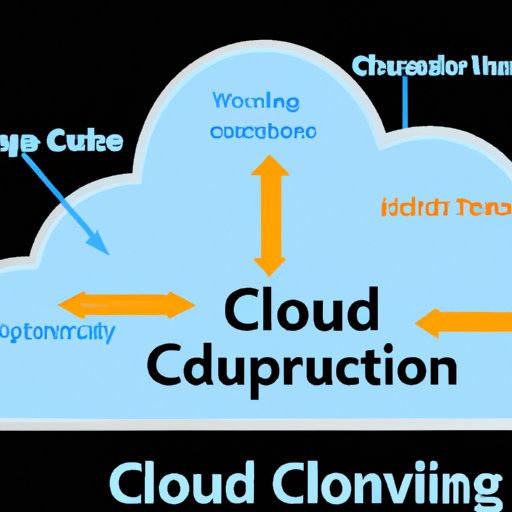Introduction
Cloud technology is a rapidly growing field in which businesses of all sizes are increasingly turning to for cost savings, increased productivity, scalability, and flexibility. This article will explore the benefits of cloud technology, offer a guide to understanding the different types of cloud services, and discuss how the cloud is changing business strategies and impacting security.
Exploring the Benefits of Cloud Technology
At its core, cloud technology is about accessing software, applications, and other services over the internet. Companies use cloud computing to store and access data on remote servers rather than local hard drives, providing a variety of benefits.
Cost Savings
The cloud offers businesses an efficient way to reduce costs. According to a study by Gartner, “Cloud computing has a lower total cost of ownership compared to traditional IT solutions due to reduced IT infrastructure costs, staff costs, and software licensing fees.” By leveraging the cloud, companies can save money on hardware, software, and other IT investments.
Increased Productivity
Cloud technology also enables businesses to increase productivity and efficiency. With the cloud, teams can easily collaborate and share documents and files, allowing them to work together more quickly and efficiently. Additionally, cloud-based applications are often easier to use and require less training, resulting in faster adoption and improved user experience.
Scalability
The cloud makes it easy for businesses to scale up or down depending on their needs. Companies can add or remove users and resources as needed without having to purchase additional hardware or software. This allows businesses to quickly adapt to changing market conditions and customer demands.
Flexibility
Finally, cloud technology provides businesses with greater flexibility. Companies can access cloud-based applications from any device and location, allowing employees to work remotely and be more productive. Additionally, cloud-based applications can be updated quickly and easily, making it easy for businesses to stay up to date with the latest features and technologies.

A Guide to Understanding Cloud Computing
Cloud computing is a broad term that encompasses a wide range of services, including Infrastructure as a Service (IaaS), Platform as a Service (PaaS), Software as a Service (SaaS), and Network as a Service (NaaS). Let’s take a closer look at each of these types of cloud services.
Types of Cloud Services
IaaS is a type of cloud service that provides virtualized computing resources such as servers, storage, and networking. It allows businesses to outsource their IT infrastructure to a third-party provider, eliminating the need to purchase, manage, and maintain physical hardware.
Infrastructure as a Service (IaaS)
Platform as a Service (PaaS) is a type of cloud service that provides a platform for developing, testing, delivering, and managing applications. PaaS solutions provide developers with tools and frameworks for building applications quickly and easily.
Platform as a Service (PaaS)
Software as a Service (SaaS) is a type of cloud service that provides access to software applications over the internet. SaaS solutions are typically subscription-based and can be accessed from any device with an internet connection.
Software as a Service (SaaS)
Network as a Service (NaaS) is a type of cloud service that provides network connectivity and resources via the internet. NaaS solutions allow businesses to quickly establish secure and reliable connections between their networks and the cloud.
Network as a Service (NaaS)
By leveraging the power of cloud services, businesses can quickly and easily deploy and manage their applications, infrastructure, and networks.
How the Cloud is Changing Business Strategies
The cloud is revolutionizing the way businesses operate, enabling companies to improve collaboration, enhance mobility, and automate tasks. Here’s a closer look at how the cloud is reshaping business strategies.
Improved Collaboration
With cloud-based applications, teams can easily share and collaborate on documents and files in real time. This eliminates the need for emails and file transfers, which can slow down the process. Additionally, cloud-based applications enable teams to work together from any location, allowing for more efficient collaboration.
Enhanced Mobility
Cloud-based applications offer enhanced mobility, allowing employees to access their data from any device, anywhere. This makes it easier for teams to stay connected and productive, even when they’re away from the office.
Automation
Cloud technology enables businesses to automate manual processes, such as data entry, invoicing, and reporting. Automation helps streamline operations and reduce costs, while freeing up employees to focus on more strategic tasks.

How Cloud Computing Impacts Security
When it comes to security, the cloud provides numerous benefits. Cloud providers employ a variety of measures to ensure data is protected, including encryption, authentication, and isolation.
Encryption
Cloud providers use encryption to protect data from unauthorized access. Data is encrypted both in transit and at rest, ensuring that only authorized users can view and modify the information.
Authentication
Cloud providers also use authentication to verify the identity of users. This ensures that only authorized users are allowed to access sensitive data.
Isolation
Cloud providers also use isolation to ensure that data is kept separate from other users. This prevents malicious users from accessing another user’s data or using it to launch attacks.

The Future of Cloud Computing
As cloud technology continues to evolve, it is opening up new possibilities for businesses. Artificial intelligence (AI), the Internet of Things (IoT), and edge computing are just a few of the emerging technologies that are transforming the way businesses use the cloud.
Artificial Intelligence
AI is becoming increasingly popular in the cloud, as it allows businesses to automate processes and make decisions based on data. AI can help businesses improve customer service, optimize operations, and gain insights into customer behavior.
Internet of Things
The IoT is a network of connected devices that can collect and exchange data. Through the cloud, businesses can leverage the IoT to gather data from a variety of sources, enabling them to make better informed decisions.
Edge Computing
Edge computing is a distributed computing model in which data is processed at the edge of a network, rather than in a centralized data center. Edge computing can help businesses reduce latency and improve performance, making it ideal for applications that require real-time data processing.
Cloud Technology: Pros and Cons
Like any other technology, cloud computing has its pros and cons. Here’s a quick look at some of the advantages and disadvantages of cloud technology.
Advantages
The biggest advantage of cloud technology is cost savings. Cloud computing eliminates the need to invest in hardware and software, reducing IT costs significantly. Additionally, cloud-based applications are often easier to use and require less training, resulting in faster adoption and improved user experience.
Disadvantages
One of the drawbacks of cloud computing is security. While cloud providers employ a variety of measures to ensure data is protected, there is still a risk of data breaches. Additionally, businesses may experience delays or disruptions if the cloud provider experiences downtime.
Conclusion
Cloud technology offers businesses a variety of benefits, from cost savings to increased productivity. It also provides a number of services, such as Infrastructure as a Service (IaaS), Platform as a Service (PaaS), Software as a Service (SaaS), and Network as a Service (NaaS). The cloud is revolutionizing the way businesses operate, enabling companies to improve collaboration, enhance mobility, and automate tasks. Additionally, cloud computing is impacting security, with providers employing measures such as encryption, authentication, and isolation to protect data. As cloud technology continues to evolve, businesses can look forward to new possibilities, such as artificial intelligence, the Internet of Things, and edge computing. Ultimately, cloud technology has both advantages and disadvantages, so it’s important for businesses to weigh the pros and cons before making the decision to move to the cloud.
(Note: Is this article not meeting your expectations? Do you have knowledge or insights to share? Unlock new opportunities and expand your reach by joining our authors team. Click Registration to join us and share your expertise with our readers.)
